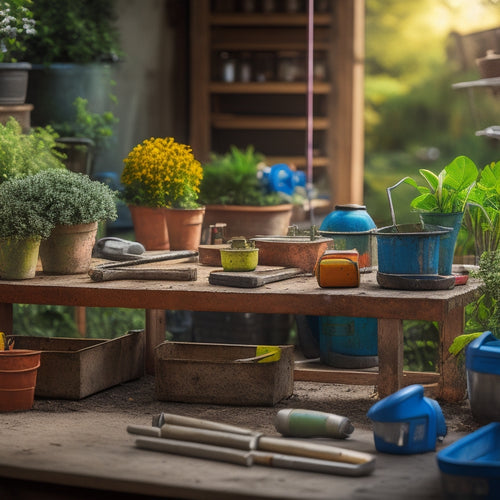
Finishing Tools for Home Depot Concrete Steps
Share
When finishing your Home Depot concrete steps, you'll need a variety of specialized tools to achieve a professional-looking finish. Essential tools include trowels, edgers, and jointers for smooth, clean edges and joints. You'll also need floating and finishing blades, which require precise angle adjustments and regular maintenance for peak performance. Additionally, consider investing in power tools like walk-behind power trowels and grinders, as well as hand tools like stiff-bristled brooms and finishing trowels. As you explore the world of concrete finishing, you'll discover more techniques and tools to help you master this complex process and unleash the full potential of your steps.
Key Takeaways
• Use a small margin trowel for tight spaces and a larger finishing trowel for open areas to achieve a smooth finish on concrete steps.
• Edgers come in various sizes and shapes to create clean, sharp edges and curves, and are essential for defined edges and joints.
• Jointers are necessary for finishing joints between steps to ensure seamless transitions and a professional-looking finish.
• Regular maintenance of tools is crucial to extend their lifespan and ensure peak performance when finishing concrete steps.
• Choose the right blade type, including diamond or abrasion blades, and adjust the blade angle correctly to achieve the desired finish.
Essential Finishing Tools for Steps
Select a set of essential finishing tools, including trowels, edgers, and jointers, to achieve a smooth, even, and durable concrete step finish.
You'll need a range of trowels, from a small margin trowel for tight spaces to a larger finishing trowel for open areas. Edgers, which come in various sizes and shapes, are designed for creating clean, sharp edges and curves. Jointers, used for finishing joints between steps, guarantee a seamless shift.
When choosing your tools, prioritize tool safety. Look for ergonomic handles and durable materials that can withstand heavy use. It's also vital to maintain your tools properly to prevent damage and guarantee peak performance. Regularly clean and store your tools to extend their lifespan.
To guarantee step durability, focus on achieving a smooth, even finish. This will help prevent water from seeping into the concrete and causing damage.
Tamping and Edging Techniques
To achieve a smooth, even finish, you'll need to master two critical techniques: tamping and edging, which require precision and control to produce professional-looking concrete steps.
Tamping techniques involve using a tamping tool to compact and flatten the concrete, ensuring it's even and level. You'll need to apply gentle, consistent pressure, working in small sections to avoid creating air pockets or unevenness. Pay attention to the concrete's consistency and adjust your tamping technique accordingly – if it's too wet, you may need to use a more aggressive approach, while drier concrete requires a lighter touch.
When it comes to edging, you'll need to choose an edging style that suits your desired aesthetic. Popular edging styles include a rounded edge, a square edge, or a decorative edge. Regardless of the style, it's crucial to maintain control and precision, using an edging tool to create a clean, defined edge. Avoid applying too much pressure, which can cause the concrete to chip or crack.
Floating and Finishing Blades
When you're working with floating and finishing blades, you'll need to contemplate a few key factors to achieve a smooth, even finish.
You'll want to select the right blade for the job, taking into account the type of concrete, the desired finish, and the blade's durability.
Blade Selection Criteria
How do you determine which floating and finishing blades are best suited for your concrete steps, taking into account the multitude of options available on the market?
The key lies in understanding the blade selection criteria that cater to your specific needs.
When choosing a blade, you should evaluate the blade material. Diamond blades, for instance, are ideal for aggressive cutting and removing old concrete, while abrasion blades are better suited for smoothing and polishing.
Blade size is another significant factor to evaluate. A larger blade size typically covers more surface area, allowing for faster completion of tasks, but may be heavier and more difficult to handle. On the other hand, smaller blades provide more precision and control, making them perfect for intricate work or tight spaces.
Additionally, you should also reflect on the blade's segment style, bond type, and horsepower requirements.
Blade Angle Matters
As you prepare to tackle your concrete step project, understanding the ideal blade angle for your floating and finishing blades is vital, as it directly impacts the quality of the finish and the efficiency of the process.
When it comes to floating blades, a steeper angle (typically between 20° to 30°) is recommended to effectively remove excess material and achieve a smooth surface. This angle allows the blade to 'float' across the concrete, removing imperfections and leaving a uniform finish.
For finishing blades, a shallower angle (usually between 10° to 20°) is preferred to achieve a high-gloss finish. This angle enables the blade to make precise, controlled cuts, reducing the risk of scratches and marks.
It's essential to adjust the blade angle according to the specific blade type and the desired finish. Failing to do so can result in a subpar finish, wasted time, and increased costs.
Proper Blade Maintenance
You must regularly inspect and maintain your floating and finishing blades to guarantee they remain in peak condition, as dull or damaged blades can compromise the quality of your concrete step finish.
Proper maintenance involves more than just cleaning your blades. Here are some essential tips to keep in mind:
-
Check for wear and tear: Inspect your blades for signs of wear, such as chipped or broken teeth, and replace them as needed.
-
Clean your blades regularly: Use a wire brush or cloth to remove concrete residue and debris from your blades.
-
Sharpen your blades: Use a diamond stone or other sharpening tool to maintain the blade's cutting edge.
-
Store your blades properly: Keep your blades in a dry, protected area to prevent rust or corrosion.
-
Use the right blade for the job: Choose the correct blade type for your specific concrete finishing task, whether it's a floating blade for rough finishing or a finishing blade for final touches.
Concrete Step Sealing Options
When it comes to sealing your concrete steps, you'll need to evaluate the type of sealant to use, as there are several options available, each with its own benefits and drawbacks.
You'll also want to understand the benefits of sealing, such as protection from the elements and increased durability, to determine if it's worth the investment.
Sealant Types Available
Concrete step sealing options encompass a range of sealant types, each offering distinct benefits and performance characteristics that cater to specific project requirements and environmental conditions.
As you evaluate the best sealant for your concrete steps, you'll want to assess the properties and application techniques of each type.
Here are some common sealant types to keep in mind:
-
Acrylic sealers: Water-based, easy to apply, and suitable for low-traffic areas. They offer moderate protection against UV rays and water damage.
-
Polyurethane sealers: Oil-based, more durable than acrylics, and ideal for high-traffic areas. They provide excellent protection against UV rays, water, and chemicals.
-
Epoxy sealers: Highly durable, chemical-resistant, and suitable for industrial or high-traffic areas. They require a specialized application process.
-
Silane sealers: Penetrating sealers that react with concrete to form a hydrophobic (water-repelling) surface. They're ideal for protecting against water damage and freeze-thaw cycles.
-
Siloxane sealers: A blend of silane and silane-modified polyethers, offering improved performance and flexibility. They're suitable for a wide range of applications, from residential to industrial.
When selecting a sealant, take into account factors such as durability, UV resistance, and chemical resistance to guarantee the best results for your concrete steps.
Benefits of Sealing
Sealing your concrete steps with the right sealant type confers a multitude of benefits that considerably extend the lifespan and enhance the appearance of your outdoor infrastructure.
With the right sealant, you'll enjoy long-term protection against the harsh effects of weather, such as rain, snow, and sunlight, which can cause cracks, fading, and discoloration. This protection guarantees your concrete steps remain durable and stable, reducing the likelihood of costly repairs or replacements.
Moreover, sealing your concrete steps leads to aesthetic enhancement. A good sealant can enhance the natural beauty of your concrete, making it look cleaner, brighter, and more vibrant. It can also help maintain the original color and texture of your concrete, preventing it from becoming dull and worn out.
By sealing your concrete steps, you'll be able to enjoy a visually appealing outdoor space that complements your home's exterior. Additionally, a sealed concrete step will be easier to clean, reducing the time and effort required to maintain its appearance.
Sealing Frequency Needed
Depending on the level of foot traffic and exposure to the elements, you may need to reapply a sealant to your concrete steps every one to three years to maintain their protective barrier and aesthetic appeal.
To determine the ideal sealing schedule for your concrete steps, consider the following environmental factors:
-
Climate: If you live in an area with extreme temperatures, high humidity, or heavy rainfall, you may need to reapply a sealant more frequently to protect your concrete steps from damage.
-
Foot traffic: High-traffic areas, such as entranceways or stairs, may require more frequent sealing to maintain their appearance and durability.
-
Chemical exposure: If your concrete steps are exposed to chemicals, such as salt or oil, you may need to reapply a sealant more frequently to prevent damage and discoloration.
-
UV exposure: Direct sunlight can cause sealants to break down more quickly, requiring more frequent reapplication.
-
Maintenance habits: Regular cleaning and maintenance can help extend the life of your sealant, but neglecting these tasks may require more frequent reapplication.
Finishing Hand Tools for Steps
You'll need a set of specialized finishing hand tools to achieve a smooth, even finish on your concrete steps, starting with a stiff-bristled broom for initial surface preparation. This helps remove any debris or loose particles, guaranteeing a strong bond between the concrete and subsequent finishes.
Next, you'll require a trowel or float to apply and spread your chosen finish, whether it's a textured, broom-finished, or smooth design. Consider your step design considerations, such as the direction of the trowel marks, to achieve the desired aesthetic.
For finishing texture options, an edger or margin trowel is essential for creating clean lines and defined edges. A finishing trowel or darby will help you achieve a smooth, even finish.
Don't forget a level and straightedge to guarantee your steps are perfectly aligned and plumb. Finally, a soft-bristled brush or sponge can be used to add subtle texture or pattern to your finish.
With these hand tools, you'll have the control and precision needed to achieve a professional-looking finish on your concrete steps.
Power Tools for Smoothing Concrete
With your hand tools in place, it's time to bring in the power tools to further refine your concrete steps' surface, starting with a walk-behind power trowel or a ride-on power trowel to efficiently smooth out large areas. These power tool types are essential for achieving a high-quality finish.
As you work, you'll need to employ various concrete smoothing techniques to achieve the desired level of smoothness. Here are some power tools you'll want to evaluate:
-
Edgers: For creating clean, defined edges and joints
-
Floats: For smoothing and flattening the concrete surface
-
Tamping tools: For compacting and leveling the concrete
-
Grinders: For removing imperfections and achieving a high-gloss finish
-
Polishers: For applying a final, high-shine polish to your concrete steps
Concrete Step Finishing Accessories
Finishing your concrete steps requires attention to detail, and that's where concrete step finishing accessories come into play, providing the precision and control needed to achieve a professional-looking result. You'll want to reflect on the right tools to enhance the texture and design of your steps.
| Accessory | Description | Benefit |
|---|---|---|
| Edging tools | Create clean lines and smooth transitions | Enhances curb appeal |
| Stamp mats | Add texture and patterns to your concrete | Expands concrete texture techniques |
| Step form liners | Create custom step design options | Increases design flexibility |
These accessories allow you to customize your concrete steps to fit your unique style and vision. With edging tools, you can create clean lines and smooth transitions that enhance the overall appearance of your steps. Stamp mats expand your concrete texture techniques, enabling you to add intricate patterns and designs. Meanwhile, step form liners provide the flexibility to create custom step design options that fit your specific needs. By incorporating these accessories into your finishing process, you'll be able to achieve a professional-looking result that exceeds your expectations.
Achieving a Smooth Finish
To achieve a smooth finish on your concrete steps, it's essential that you screed the surface immediately after pouring, using a screed board or tamping tool to remove excess concrete and air pockets. This initial step sets the stage for a flawless finish.
Next, you'll need to focus on surface preparation, guaranteeing the concrete is even and free of imperfections.
Here are some key smoothing techniques to keep in mind:
-
Use a bull float to further flatten the surface, working in sections to maintain even coverage.
-
Apply a concrete finishing compound to fill in any minor imperfections or gaps.
-
Utilize a power trowel to achieve a high-gloss finish, or a manual trowel for a more textured look.
-
Perform a series of finishing passes with a steel trowel to remove any excess compound and achieve a smooth, even surface.
-
Finally, apply a concrete sealer to protect your steps from the elements and guarantee a long-lasting finish.
Frequently Asked Questions
Can I Use a Regular Broom to Sweep Excess Concrete off Steps?
When sweeping excess concrete off steps, you'll want to choose the right broom type to avoid spreading concrete residue.
A regular broom won't cut it, as its soft bristles will just push the concrete around.
Instead, opt for a stiff-bristled broom or a broom specifically designed for concrete, which will effectively remove excess material without leaving residue behind.
This guarantees a clean, even surface for finishing.
How Often Should I Clean My Finishing Tools to Prevent Rust?
As you're likely aware, neglecting tool maintenance can lead to costly repairs and downtime.
Coincidentally, regular cleaning is key to rust prevention. You should clean your finishing tools after every use, and perform a deep clean every week.
Dry tools thoroughly, and apply a rust-inhibiting coating to metal components.
This proactive approach guarantees your tools remain in top condition, allowing you to maintain control over your projects and avoid costly setbacks.
Are Concrete Step Finishing Tools Compatible With Other Materials?
When working with finishing tools, you'll need to take into account compatibility with various materials.
Not all tools are created equal, and using the wrong one can lead to subpar results or even damage.
You'll need to think about material-specific techniques and compatibility considerations to guarantee a seamless finish.
For instance, a tool designed for concrete mightn't be suitable for wood or metal, so it's essential to choose the right tool for the job to achieve ideal results.
Can I Finish Concrete Steps During Extreme Weather Conditions?
You might think you can finish concrete steps in any weather, but extreme conditions can be detrimental to the process.
Investigating the truth behind this theory reveals that concrete curing techniques are essential in harsh weather.
To guarantee a successful finish, you'll need to take extreme weather precautions, such as using specialized curing compounds, covering the steps, and controlling temperature fluctuations.
Do I Need to Wear Protective Gear When Using Finishing Tools?
When working with finishing tools, you'll need to prioritize your safety above all else.
You should always wear protective equipment, such as gloves, safety glasses, and a dust mask, to prevent injuries from flying debris or harsh chemicals.
Be sure to follow strict safety guidelines, like keeping loose clothing and long hair tied back, to minimize risks.
Conclusion
You've now got the skills to transform your Home Depot concrete steps into a stunning feature.
According to the American Society of Concrete Contractors, a well-finished concrete surface can increase a property's value by up to 10%.
With the right finishing tools and techniques, you can achieve a smooth, durable finish that enhances your home's curb appeal and boosts its resale value.
Related Posts
-

What Tools Do I Need for Concrete Wall Repair
As you prepare for a concrete wall repair job, you'll need a variety of tools to guarantee a successful outcome. Star...
-

Top Tools for Mixing Concrete at Home
When mixing concrete at home, you'll need a range of tools to guarantee a successful operation. Start with essential ...
-

Must-Have Tools for Concrete Planter Projects
As you commence your concrete planter project, you'll need a range of specialized tools to achieve professional-grade...


